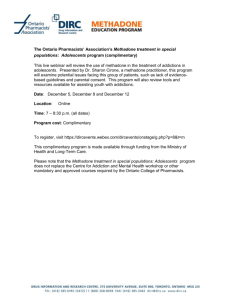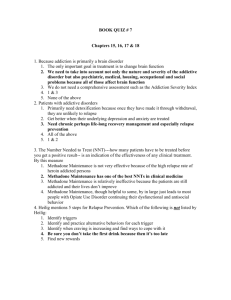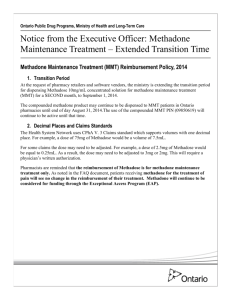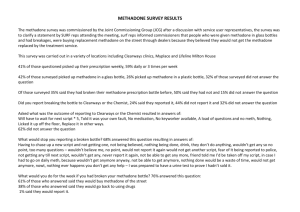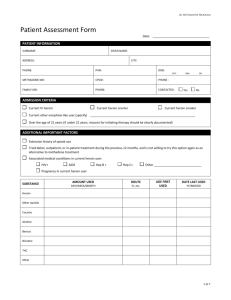Document 13732028
advertisement
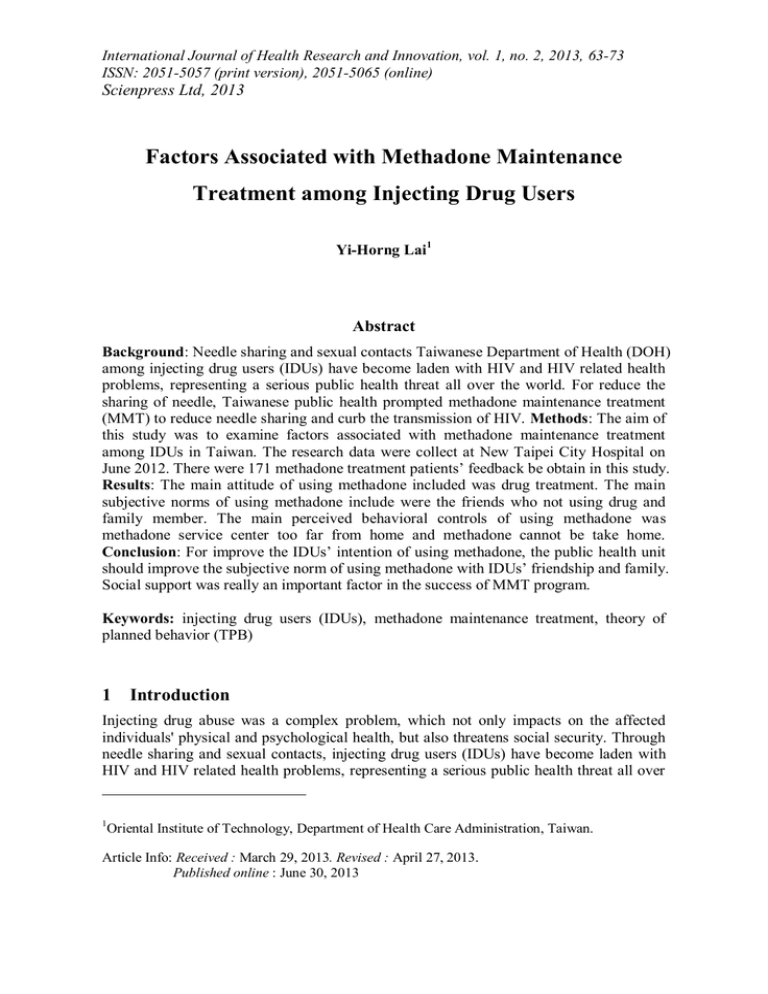
International Journal of Health Research and Innovation, vol. 1, no. 2, 2013, 63-73 ISSN: 2051-5057 (print version), 2051-5065 (online) Scienpress Ltd, 2013 Factors Associated with Methadone Maintenance Treatment among Injecting Drug Users Yi-Horng Lai1 Abstract Background: Needle sharing and sexual contacts Taiwanese Department of Health (DOH) among injecting drug users (IDUs) have become laden with HIV and HIV related health problems, representing a serious public health threat all over the world. For reduce the sharing of needle, Taiwanese public health prompted methadone maintenance treatment (MMT) to reduce needle sharing and curb the transmission of HIV. Methods: The aim of this study was to examine factors associated with methadone maintenance treatment among IDUs in Taiwan. The research data were collect at New Taipei City Hospital on June 2012. There were 171 methadone treatment patients’ feedback be obtain in this study. Results: The main attitude of using methadone included was drug treatment. The main subjective norms of using methadone include were the friends who not using drug and family member. The main perceived behavioral controls of using methadone was methadone service center too far from home and methadone cannot be take home. Conclusion: For improve the IDUs’ intention of using methadone, the public health unit should improve the subjective norm of using methadone with IDUs’ friendship and family. Social support was really an important factor in the success of MMT program. Keywords: injecting drug users (IDUs), methadone maintenance treatment, theory of planned behavior (TPB) 1 Introduction Injecting drug abuse was a complex problem, which not only impacts on the affected individuals' physical and psychological health, but also threatens social security. Through needle sharing and sexual contacts, injecting drug users (IDUs) have become laden with HIV and HIV related health problems, representing a serious public health threat all over 1 Oriental Institute of Technology, Department of Health Care Administration, Taiwan. Article Info: Received : March 29, 2013. Revised : April 27, 2013. Published online : June 30, 2013 64 Yi-Horng Lai the world. In Taiwan, since the identification of the first HIV-infected IDUs in 1987, the incident cases have continued to increase, reaching a height of 2,461 in 2005. In order to contain the epidemics of HIV among IDUs, and to prevent its spread to the population in general, a national pilot harm reduction program, which mainly included a methadone maintenance treatment (MMT) program and a needle/syringe exchange program, was implemented in Taiwan in 2005 [1]. The fact that addiction of injecting drug was officially treated as a health rather than a legal issue itself represents a remarkable milestone in Taiwan. Among these harm reduction programs, including needle and syringe exchange for IDUs as well as substitution treatment approaches for injecting drug dependence, methadone maintenance treatment perhaps represents the most important and most crucial component. Methadone treatment was introduced in Taiwan in 2006 as a harm-reduction program in response to the human immunodeficiency virus (HIV), which was endemic among Taiwanese heroin users. The present study was aimed at examining the clinical and behavioral characteristics of methadone patients in Taiwan. In addition, there has been scant research focusing on Asia, particularly Chinese populations, but analyses from other cultures were a critical component of epidemiology. In order to address some of these issues, this study adopts the theory of planned behavior (TPB) to examine factors related methadone maintenance treatment among IDUs in Taiwan. 1.1 Theory of Planned Behavior This study emphasized the importance that factors like social influence and perceived behavioral control play for methadone maintenance treatment (MMT) program. Thus, attitudinal theory provides a sound foundation to understand the intentions of methadone using. By way of a brief overview of TPB, depicts the basic framework usually applied in such studies. Ajzen [2] argues that TPB provides a sound basis to predict behavior by understanding three discrete belief categories. Beliefs for some target behavior as well as an evaluation of these beliefs; beliefs about the normative expectations of others (such as family or friends) as well as a desire to comply with these expectations; and beliefs about factors that might facilitate or impede the target behavior as well as the ability to deal with these potential impediments. Each of these categories of beliefs has subsequent implications: behavioral beliefs influence attitudes toward the behavior; normative beliefs lead to subjective norms or social pressures, and constraint or control beliefs contribute to an overall evaluation perceived behavioral control [3]. Factors Associated with Methadone Treatment among Injecting Drug Users Attitude (AT) Behavior Belief Subjective Norm (SN) Normative Belief Control Belief 65 Intention (INT) Perceived Behavioral Control (PBC) Figure 1: The Frame of the Theory of Planned Behavior In many TPB studies, behavioral intention is taken as a proxy measure of likely behavior. There are three direct factors of behavioral intention: attitude, subjective norm and perceived control, which form the core of the TPB model. The evaluating items of behavioral intentions are attitude, subjective norm, and perceived control. It is provide insight into the foundation of each of these three predictors by also collecting information about the indirect measure of attitudes, subjective norms and perceived control, as shown as Figure 1. 1.2 Attitude of Using Methadone TPB assumes attitude toward a behavior, subjective norm, and perceived behavioral control are three conceptually independent determinants of behavioral intention. The first important determinant of behavioral intention is attitude, which can be described as the degree to which a person has a favorable or unfavorable evaluation or appraisal of the behavior in question [4]. Attitude toward a behavior is believed to be a function of one‘s salient beliefs, which represent the perceived consequences of the behavior and the evaluation of the significance of the consequences [5]. When determining whether to perform a specific behavior, a person is likely to assess the benefits and the costs resulting from the behavior [6]. An individual tends to possess a favorable attitude when the outcomes are positively evaluated and, the person is likely to engage in that specific behavior. In other words, an individual‘s positive attitude toward a certain behavior strengthens his intention to perform the behavior [1]. In Zulea and Desmond’s study [7], the attitude of using methadone included prior successful treatment with methadone, and observation of methadone patients who stopped using drugs. In Wu, Cao, and Zhang’s study [8], the findings indicate an urgent need to address the issue of provider attitudes, which can impact interactions with clients and influence efforts to maintain treatment retention and outcomes for drug users. After Yen, Tsai, Wang, Yeh, Liu, Wang, and Wang examine unfavorable attitudes toward receiving methadone maintenance treatment of 315 inmates using intravenous heroin [9], they find that heroin-using inmates who were young, started using heroin earlier, perceived many 66 Yi-Horng Lai advantages and few disadvantages of heroin use, had never received methadone maintenance treatment, and had severe depression, had unfavorable attitudes toward receiving methadone maintenance treatment. Schwartz, Kelly, O'Grady, Mitchell, Peterson, Reisinger, Agar, and Brown compare two groups, one was enrolled in one of six Baltimore area methadone programs, and the other ones was out-of-treatment [10]. The in-treatment group had significantly more positive attitudes toward methadone than did the out-of-treatment group, while they did not differ in their attitudes toward buprenorphine. Both groups had significantly more positive attitudes toward buprenorphine than methadone. Addressing these attitudes may increase treatment entry and retention. 1.3 Subjective Norm of Using Methadone Based on TPB, subjective norm is suggested as a factor of behavioral intention. Ajzen [4] defined subjective norm as the perceived social pressure to perform or not to perform the behavior. In other words, subjective norm is the perceived opinions of significant others who are important to an individual and who influence one’s decision-making [11]. Subjective norm is represented as a function of a person‘s normative beliefs about what salient referents think people should do or should not do, and people motivation to comply to those referents [12]. Eagry and Chailen [5] described normative beliefs as perceptions of significant others’ preferences about whether one should engage in a behavior. In other words, it concerns the probability of whether significant referents would approve or disapprove the behavior. The important role of subjective norm as a determinant of behavioral intention is well documented in various contexts in marketing and consumer behavior [13]. When significant others think traveling as a backpacker is a proper behavior, one‘s perceived social pressure to travel as backpacker would increase with one’s motivation to comply. Sumintardja, Pinxten, Siregar, Suherman, Wisaksana, Iskandar, Tasya, Hinduan, and Hospers [14] estimate 2015 HIV infected in Indonesia for the key behaviors to HIV prevention and care are determined by a complex set of individual factors. They find that nurses, physician, and partner play an important role. 1.4 Perceived Behavioral Control of Using Methadone One of the factors of behavioral intention is perceived behavioral control. Perceived behavioral control can be described as the perceived ease or difficulty of performing the behavior [4]. In particular, perceived behavioral control assesses the perception of how well one can control factors that may constrain the actions needed to deal with a specific situation. Perceived behavioral control is determined to be a function of control beliefs that refer to one‘s perception of the presence/absence of resources required to perform a specific behavior, and his assessment of the level of importance of such resources for the achievement of outcomes [3]. A number of studies have demonstrated that people‘s intention is positively influenced by their self confidence in their ability to perform the behavior [6]. Findings in these studies imply that when an individual holds little control over carrying out a certain behavior because of the lack of availability of required resources, one’s behavioral intention will be lower in spite of the fact that one has positive attitude norm concerning the intended act. Factors Associated with Methadone Treatment among Injecting Drug Users 2 67 Methods The research frame of this study was build based on TPB. TPB is an established theoretical model of explaining the relationship between beliefs, attitudes, intentions, and behaviors [4]. TPB has been applied in a variety of studies on social behavior, including studies on the decisions of students completing high school, consumer choices of transportation mode, the influence of negative word-of-mouth on Chinese consumers’ intention of choosing restaurants to dine at and, attitudes toward wine tourism. The research frame of this study was as Figure 2. 2.1 Research Data The research data were collect at New Taipei City Hospital from June 1, 2012 to June 30, 2012. There were 171 methadone treatment patients’ feedback be obtain in this study. New Taipei City Hospital was one of MMT program hospital, and provided MMT service from 2006. There were about 300 MMT clinic patients in New Taipei City Hospital now. 2.2 Research Tools The questionnaire was build base on Tsai’s study [15]. Tsai in-depth interviewed with 17 IDUs with methadone maintenance treatment in Taiwan. The result of Tsai’s study [15] could be separate three parts as the attitude, the subjective norm, and the perceived behavioral control. The items of attitudes of using methadone included: (1) For reduce the harm of drugs on health. (2) The family members’ preference. (3) Reduce the spending of drugs. (4) Reduce the pain of drug seizures. (5) Emotionally stable. (6) Drug treatment. (7) Reduce the sharing of needles. (8) Reduce the risk of AIDS. (9) The addiction of methadone. The items of subjective norms of using methadone include: (1) The suggestion of the friends who using drug. (2) The suggestion of the friends who not using drug. (3) The suggestion of family. 68 Yi-Horng Lai 1. Reduce Harm 2. Family Prefer 3. Reduce Spending 4. Reduce Pain 5. Emotionally Stable AT of Using Methadone 6. Drug Treatment 7. Sharing of Needles 8. The Risk of AIDS 9. Addiction 1. Drug friends 2. Non-Drug Friends SN of Using Methadone 3. Family 1. Distance 2. Price of methadone 3. Police Meeting 4. Boss Meeting 5. Acquaintance Meeting PBC of Using Methadone 6. Service Time 7. Waiting List 8. Take Home Figure 2: The Research Frame of This Study The items of perceived behavioral controls of using methadone include: (1) Methadone service center too far from home (2) The price of using methadone (3) Meet the police in methadone service center (4) The boss would know I am methadone taker (5) Meet acquaintance in methadone service center INT of Using Methadone Factors Associated with Methadone Treatment among Injecting Drug Users 69 (6) Using methadone time cannot be tie their own time (7) Re-enter the waiting list after interrupt treatment (8) Methadone cannot be took home 2.3 Data Analysis The data that be collected in this study would be analysis by linear regression methodology with R 2.15.2 computer software. There are 4 regression models in this study. The overall model was the model with the dependent variable of the intention of using methadone and the independent variable of the attitude, the subjective norm, and the perceived behavioral control. The attitude model was the model with the dependent variable of the attitude of using methadone and the independent variables of reduce the harm of drugs on health, the prefer of family, reduce the spending of drugs, reduce the pain of drug seizures, emotionally stable, drug treatment, reduce the sharing of needles, reduce the risk of AIDS, and drug addiction. The subjective norm model was the model with the dependent variable of the subjective norm of using methadone and the independent variables of the suggestion of the friends who using drug, the suggestion of the friends who not using drug, and the suggestion of family. The subjective norm model was the model with the dependent variable of the subjective norm of using methadone and the independent variables of the suggestion of the friends who using drug, the suggestion of the friends who not using drug, and the suggestion of family. 3 Results There were 171 methadone treatment patients’ feedback in this study. The demographic profile of the sample is shown as Table 1. A total of 171 successful responses were received from participants. In the 171 respondents, male and female are 86.0% and 14.0% respectively. 88.9% of these participants’ sexual behavior were straight, 10.5% of them were gay, and 0.6% of them were bisexual. 14.6% of participants were no profession, and 85.4% of them were with profession. Gender Sexual behavior Profession HIV Screening Total Table 1: Sample Characteristics Characteristics Frequency Male 147 Female 24 Straight 152 Gay 18 Bisexual 1 No 25 With 146 Yes 10 No 161 171 Percent (%) 85.96 14.04 88.89 10.53 .58 14.62 85.38 5.85 94.15 100.00 70 Yi-Horng Lai 3.1 The Attitude of Using Methadone The regression model of attitude of using methadone was the model with the dependent variable of the attitude of using methadone and the independent variables of reduce the harm of drugs on health, the prefer of family, reduce the spending of drugs, reduce the pain of drug seizures, emotionally stable, drug treatment, reduce the sharing of needles, reduce the risk of AIDS, and drug addiction. The result of the regression analysis to the attitude of using methadone was as table 2. With Table 2, it could be find that drug treatment was significant (P-value <0.05). The drug treatment was positive with the attitude of using methadone. The multiple R-squared of this model was 0.14, and the adjusted R-squared of this model was 0.09361. Table 2: Regression Analysis to the Attitude of Using Methadone Estimate S.E. t-value 1. Reduce the harm of drugs on health .03 .02 1.30 2. The prefer of family .01 .03 .09 3. Reduce the spending of drugs -.03 .03 -1.15 4. Reduce the pain of drug seizures .01 .02 .31 5. Emotionally stable -.01 .02 -.49 6. Drug treatment .08 .03 2.62 7. Reduce the sharing of needles -.01 .03 -.15 8. Reduce the risk of AIDS .01 .02 .52 9. Drug addiction -.01 .02 -.22 P-value .20 .93 .25 .76 .62 .01 .88 .61 .83 3.2 The Subjective Norm of Using Methadone The regression model of the subjective norm of using methadone was the model with the dependent variable of the subjective norm of using methadone and the independent variables of the suggestion of the friends who using drug, the suggestion of the friends who not using drug, and the suggestion of family. The result of the regression analysis to the subjective norm of using methadone was as Table 3. With Table 3, it could be find that the friends who using drug, the friends who not using drug, and family were significant (P-value <0.05). The suggestion of the friends who not using drug and the suggestion of family were positive with the subjective norm of using methadone. The multiple R-squared of this model was 0.31, and the adjusted R-squared of this model was 0.30. Table 3: Regression Analysis to the Subjective Norm of Using Methadone Estimate S.E. t-value P-value 1. The friends who using drug .03 .02 1.97 .05 2. The friends who not using drug .03 .02 2.01 .04 3. Family member .06 .01 4.36 <.00 3.3 The Perceived Behavioral Control of Using Methadone The regression model of the subjective norm of the regression analysis to the perceived behavioral control of using methadone was the model with the dependent variable of the perceived behavioral control of using methadone and the independent variables of Factors Associated with Methadone Treatment among Injecting Drug Users 71 methadone service center too far from home, the cost of using methadone, meet the police in methadone service center, the boss would know I am methadone taker, meet acquaintance in methadone service center, using methadone time cannot be tie their own time, re-enter the waiting list after interrupt treatment, and methadone cannot be take home. The result of the regression analysis to the perceived behavioral control of using methadone was as Table 4. Table 4: Regression Analysis to the Perceived Behavioral Control of Using Methadone Estimate S.E. t-value P-value 1. Methadone service center too far .05 .03 2.46 .03 from home 2. The price of using methadone -.02 .02 -.91 .39 3. Meet the police in methadone service center 4. The boss would know I am methadone taker 5. Meet acquaintance in methadone service center 6. Using methadone time cannot be tie their own time 7. Re-enter the waiting list after interrupt treatment 8. Methadone cannot be take home -.01 .02 -.31 .64 .01 .02 .50 .80 -.01 .03 -.66 .59 .03 .02 1.03 .14 .02 .02 .44 .21 .04 .02 2.58 .02 With Table 4, it could be find that methadone service center too far from home and methadone cannot be taken home were significant (P-value <0.05). The methadone service center too far from home and methadone cannot be taken home were positive with the perceived behavioral control of using methadone. The multiple R-squared of this model was 0.18, and the adjusted R-squared of this model was 0.14. 3.4 The Intention of Using Methadone The model of the intention of using methadone was the model with the dependent variable of the intention of using methadone and the independent variable of the attitude, the subjective norm, and the perceived behavioral control. The result of the regression analysis to the intention of using methadone was as Table 5. Table 5: Regression Analysis to the Intention of Using Methadone Estimate S.E. t-value P-value 1. The Attitude .14 .09 1.65 .10 2. The Subjective Norm .42 .08 4.96 <.01 3. The Perceived Behavioral Control .01 .08 .13 .89 72 Yi-Horng Lai With Table 5, it could be find that the subjective norm was significant (P-value <0.05). The subjective norm was positive with the intention of using methadone. The multiple R-squared of this model was 0.17, and the adjusted R-squared of this model was 0.16. 4 Discussion and Conclusion The objective of this study was finding the effect of injecting drug user join MMT program with TPB, and finding the effect of the attitude, the subjective norm, and the perceived behavioral control for using methadone. With the result of this study, it could be find that the drug treatment was positive with the attitude of using methadone, and the result was the same as Tsai [15]. The aim of harm reduction in Taiwan was tried to be effective against HIV/AIDS among IDUs. However, the main aim of methadone user was drug treatment. The intention of these methadone users was the same as Taiwanese public health unit. The suggestion of the friends who not using drug and the suggestion of family were positive with the subjective norm of using methadone. The result was the same as Tsai [15]. The family and friends who not using drug play an important role in MMT program. The methadone service center too far from home and methadone cannot be take home were positive with the perceived behavioral control of using methadone. The result was the same as Tsai [15]. More methadone service centers can improve IDUs’ which of using methadone. The subjective norm was positive with the intention of using methadone, and the result was the same as Tsai [15], Gu, Lau, Chen, Tsui, & Ling, [16]. For improve the IDUs’ intention of using methadone, the public health unit should improve the subjective norm of using methadone with IDUs’ friendship and family. Social support was really an important factor in the success of MMT program. References [1] [2] [3] [4] [5] [6] Lee, H.Y., Yang, Y.H., Yu, W.J., Su, L.W., Lin, T.Y., Chiu, H.J., Tang, H.P., Lin, C.Y., Pan, R.N., & Li, J.H., Essentiality of HIV testing and education for effective HIV control in the national pilot harm reduction program: The Taiwan experience, Kaohsiung Journal of Medical Sciences, 28(2), (2012), 79-85. Ajzen, I., Consumer attitudes and behavior, In C. P. Haugtvedt, P. M. Herr, & F. R. Cardes (Eds.), Handbook of consumer psychology. NY: Lawrence Erlbaum Associates, 2008, Ajzen, I., & Madden, T., Prediction of goal-directed behavior: attitude, intentions, and perceived behavioral control, Journal of Experimental Social Psychology, 22, (1986), 453-474. Ajzen, I., The theory of planned behavior, Organizational Behavior and Human Decision Processes, 50, (1991), 179-211. Eagry, A. H., & Chailen, S., Psychology of Attitudes, Fort Worth, TX: Harcourt Brace Jovanovich, 1993. Cheng, S., Lam, T., & Hsu, C. H. C., Negative word-of-mouth communication intention: an application of the theory of planned behavior, Journal of Hospitality & Tourism Research, 30(1), (2006), 95-116. Factors Associated with Methadone Treatment among Injecting Drug Users [7] [8] [9] [10] [11] [12] [13] [14] [15] [16] 73 Zule, W.A. & Desmond, D.P., Attitudes Toward Methadone Maintenance: Implications for HIV Prevention, Journal of Psychoactive Drugs, 30(1), (1998), 89-97. Wu, Z., Cao, X., Zhang, L., Provider-Client Interaction in Methadone Treatment Clinics in China, Journal of Drug Issues, 42(2), (2012), 147-155. Yen, C.F., Tsai, J.J., Wang, P.W., Yeh, Y.C., Liu, S.C., Wang, S.H., and Wang, C.C., Unfavorable attitudes toward receiving methadone maintenance therapy and associated factors among the inmates using intravenous heroin, The Kaohsiung Journal of Medical Sciences, 27(1), (2011), 27-33. Schwartz, R.P., Kelly, S.M., O'Grady, K.E., Mitchell, S.G., Peterson, J.A., Reisinger, H.S., Agar, M.H., and Brown, B.S., Attitudes Toward Buprenorphine and Methadone Among Opioid-Dependent Individuals, American Journal on Addictions, 17(5), (2008), 396-401. Hee, S. P., Relationships among attitudes and subjective norm: testing the theory of reasoned action across cultures, Communication Studies, 51(2), (2000), 162–175. Ajzen, I., & Fishbein, M., Understanding attitude and predicting social behavior, Englewood Cliffs, NJ: Prentice-Hall, Inc, 1980. Baker, E. W., Al-Gahtani, S. S., & Hubona, G. S., The effects of gender and age on new technology implementation in a developing country: testing the theory of planned behavior (TPB), Information Technology & People, 20(4), (2007), 352-375 Sumintardja, E.N., Pinxten, L.W., Siregar, J.R., Suherman, H., Wisaksana, R., Iskandar, S., Tasya, I.A., Hinduan, Z., and Hospers, H.J., Behavioral aspects of HIV prevention and care in Indonesia: A plea for a multi-disciplinary, theory and evidence-based approach, Acta Med Indones, 41(1), (2009), 79-86. Tsai, S.H., Exporing Factors Related Methadone Maintenance Treatment among Injecting Drug Users, Master thesis of Institute of school of nursing, National Yang-Ming University, 2009. Gu, J., Lau, J.T.F., Chen, H., Tsui, H., & Ling, W., Prevalence and factors related to syringe sharing behaviors among female injecting drug users who are also sex workers in China, International Journal of Drug Policy, 22(1), (2011), 26-33.
